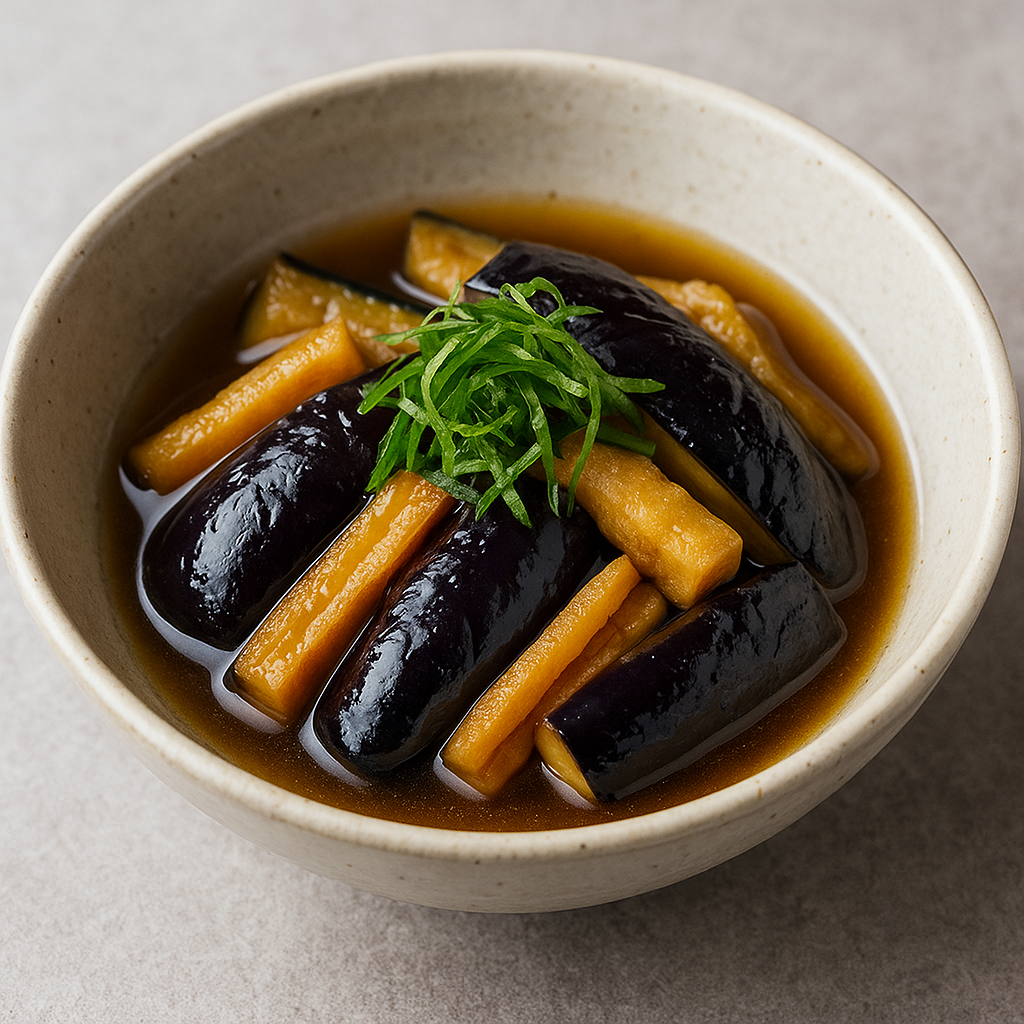なす炒り(宮城)の特徴
醤油の香りをまとわせた、なすの炒り煮
「なす炒り」は、油で焼きつけたなすに醤油だれを絡めて煮含める宮城の惣菜です。香ばしさとやわらかな食感、醤油のコクが重なり、ごはんのお供として親しまれています。
醤油で深みを、香味野菜で軽やかさを
醤油をベースに、だし・みりん・砂糖を合わせた甘じょっぱい味わいが特徴です。生姜や長ねぎを先に香り立たせ、仕上げに青じそや白ごまで後味をする場合もあります。
なす炒り(宮城) レシピ
材料(4人分)
- なす … 4本(約400g・縦十字に切り、5cmの長さにする)
- 油揚げ … 1枚(短冊切り・熱湯を回しかけて油抜き)
- 菜種油 … 大さじ2
- 醤油 … 大さじ2と1/2
- 砂糖 … 大さじ1
- みりん … 大さじ1
- 青じそ … 6枚(細切り)
- 塩 … 少々(なす下処理用)
作り方
- なすは塩少々を溶いた水に5分さらし、水気を拭き取る。
- 小ボウルでだし・醤油・砂糖・みりん・を混ぜ、たれを作る。
- フライパンに菜種油を熱し、なすを炒め、強めの中火で表面に軽く焼き色がつくまで炒める。
- 油揚げを加えてさっと炒め合わせる。
- たれを回し入れ、中火で混ぜながら煮絡める。
- 汁気が少なくなり艶が出たら火を止める。
- 器に盛り、青じそをのせる。
シェフのワンポイントアドバイス
- なすは塩水にさらして水気を拭くと、油の吸い過ぎと変色を防げます。
- 味噌だれは先に溶いておくとダマや焦げ付きが起きにくいです。
- 煮詰めすぎず、全体に艶が出た段階で火を止めると、食感と風味がきれいに残ります。
栄養価(1人分の目安)
- エネルギー … 約180〜260 kcal
- たんぱく質 … 約5〜8 g
- 脂質 … 約12〜18 g
- 炭水化物 … 約9〜14 g
- 食物繊維 … 約3〜5 g
- 食塩相当量 … 約1.6〜2.2 g
歴史
味噌文化と「炒り煮」の知恵
醤油を使ってもいいですが、仙台味噌を軸に、炒めてから煮含める「炒り煮」は宮城の家庭料理に根付いた手法です。なすの水分と味噌だれを絡め、うま味を閉じ込めます。
日々の惣菜としての広がり
大量に作って常備しやすく、弁当のおかずにも重宝されてきました。油揚げや季節の野菜を合わせることで栄養と食べ応えを補います。
季節の香りを重ねる工夫
夏から初秋のなすを主役に、青じそや生姜など香味を添える食べ方が定着しました。地域の好みに合わせて甘辛の加減を調整します。
English Version
Features of Nasu Iri (Soy-Sauce Braised Eggplant) (Miyagi)
A fragrant “iri-ni” of eggplant glazed with soy
Nasu iri is a home-style dish from Miyagi where eggplant is seared in oil, then simmer-glazed with a soy-based sauce. The charred aroma, tender texture, and savory depth make it a beloved partner for rice.
Soy sauce for depth, aromatics for lift
The seasoning blends soy sauce, dashi, mirin, and sugar into a gently sweet-salty glaze. Ginger and long onion can be used to perfume the oil, and a finish of shredded shiso adds a light, clean aftertaste.
Recipe – Nasu Iri (Miyagi)
Ingredients (Serves 4)
- Eggplant … 4 (about 400 g; halved lengthwise, then cut into 5 cm pieces)
- Aburaage (fried tofu) … 1 sheet, cut into strips (pour over boiling water to remove excess oil)
- Canola oil … 2 tbsp
- Soy sauce … 2½ tbsp
- Sugar … 1 tbsp
- Mirin … 1 tbsp
- Dashi … 150 ml
- Shiso leaves … 6, finely shredded
- Salt … a pinch (for soaking the eggplant)
Directions
- Soak eggplant in lightly salted water for 5 minutes. Drain and pat thoroughly dry.
- In a small bowl, combine dashi, soy sauce, sugar, and mirin to make the sauce.
- Heat canola oil in a large skillet. Add eggplant and stir-fry over medium-high heat until lightly browned.
- Add aburaage and toss briefly.
- Pour in the sauce and cook over medium heat, stirring to coat as it reduces.
- When most of the liquid has evaporated and the surface turns glossy, remove from heat.
- Plate and garnish with shredded shiso.
Chef’s Tips
- Soaking in salted water and drying well curbs discoloration and prevents excess oil absorption.
- Pre-mix the soy sauce glaze so it reduces evenly without clumping or scorching.
- Stop the heat when a gentle sheen appears—over-reduction can dull texture and flavor.
Nutrition (per serving, approx.)
- Energy … 180–260 kcal
- Protein … 5–8 g
- Fat … 12–18 g
- Carbohydrates … 9–14 g
- Dietary fiber … 3–5 g
- Salt equivalent … 1.6–2.2 g
History
Soy-glazed “iri-ni” rooted in Miyagi homes
The technique of searing then simmering to glaze—known as iri-ni—is a staple of Miyagi home cooking. While miso-based versions are also common in the region, a soy-sauce glaze highlights eggplant’s sweetness with a lighter finish.
Everyday side with seasonal aromas
Cooked in generous batches and served warm or at room temperature, it suits lunchboxes and daily meals. Summer-to-early-autumn eggplant pairs naturally with ginger and shiso, with sweetness-saltiness balanced to local taste.



何でも質問してください!